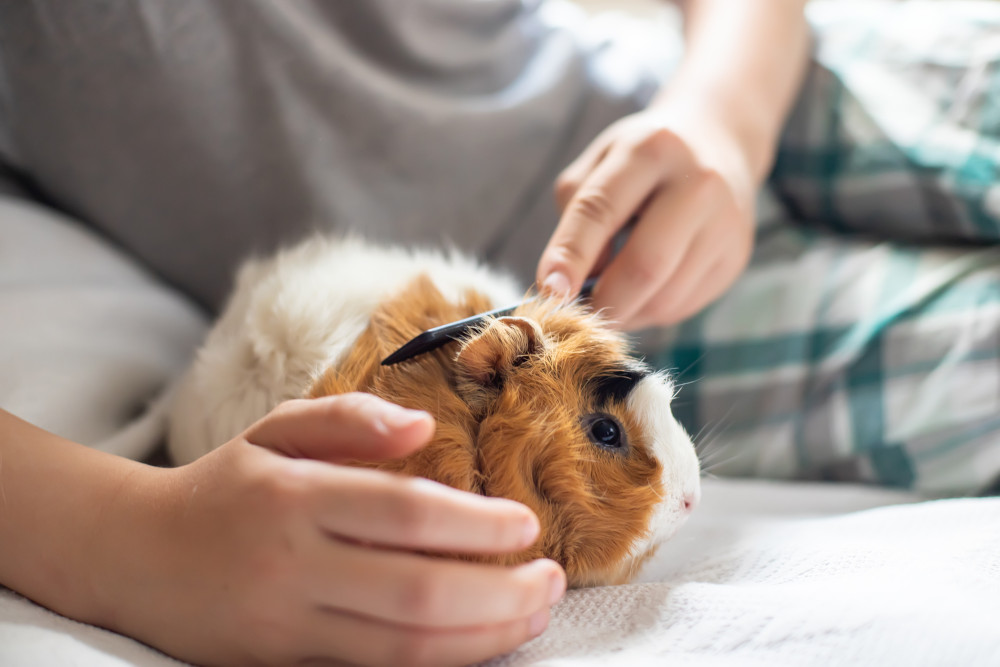
Regular grooming is essential for all guinea pigs. Not only does it keep their coat clean and shiny, but it’s also an opportunity to spend time with each other and work on the bond between a person and their companion guinea pig. During grooming take the opportunity to check your guinea pigs’ health and to ensure that they are free from external parasites, such as fleas and mites which cause itching and skin irritation.
Brushing
Long-haired guinea pigs will need daily brushing to help keep their coat in good condition. Daily brushing is also good for short-haired guinea pigs. Use a small, stiff brush and a small metal comb and brush in the direction your guinea pig’s hair is going. The need for brushing depends on how long your guinea pig’s hair is and whether your guinea pig is shedding excessively.
Long-haired guinea pig breeds should have any mats combed out every day. If you have a hard time managing the long coat, the hair can also be trimmed to manage more easily. Simply trim the longer hair so it’s not dragging on the ground using hair scissors or see a groomer for advice.
Short-haired guinea pigs only need to be brushed about once a week, but if they are shedding and losing more hair than usual, brush them at least every other day.
Bathing your guinea pigs
Bathing is quite stressful for guinea pigs but thankfully there are only a few reasons why your guinea pigs would ever need to get a bath. Unless your guinea pigs get lice, or has urine or faeces on their fur, or is about to be in a show or other competition, you’ll probably never have to bathe your guinea pigs if you brush them regularly. If you do give your guinea pigs a bath, use a shampoo designed especially for guinea pigs. Otherwise, use a mild unscented, non-medicated shampoo that is safe for use on kittens.
Prepare a shallow pan of warm water and place your guinea pig in it. Using a small cup, gently pour water over your guinea pig’s body, being careful to avoid the face.
Using a suitable brush, brush the coat gently in the same direction as the hair grows, and gently remove dead hairs, tangles and pieces of twigs, dry leaves, or burrs. Also check the length of your guinea pigs’ toenails (ask your veterinarian to teach you to assess whether the nails need clipping). If the toenails are found to be overlong, have them clipped by a veterinarian or someone experienced in clipping guinea pigs’ toenails (you can also ask your veterinarian to teach you how to safely clip the nails). Lather your guinea pig’s body with the shampoo (avoid getting the shampoo or water in their eyes or ears). Rinse the shampoo off very well and towel dry your guinea pig as best as you can. Make sure your guinea pig stays in a nice warm place until it is completely dry to avoid it getting a chill and getting sick. Don’t use a hair dryer – too loud, too hot, too scary!
Trimming the nails
Guinea pigs, especially those kept indoors and a little overweight, will develop overgrown nails. These will start to turn the foot sideways and can cause bumblefoot (pododermatitis), an ulcer on the sole of the foot.
You can use human nail clippers or nail clippers designed for cats and other small animals. These look like little scissors with small notches toward the end of the blade for cutting the nail. Some people even use nail clippers meant for babies, but nail clippers designed for dogs are too large.
Try to clip your guinea pig’s nails at least once a month, although you can do it more often if necessary. As the nails get longer, the blood vessel called the “quick” gets longer too and the nails will start to curl. Regular nail clipping helps keep the nails in good shape for walking and the quick at an appropriate length for trimming.
